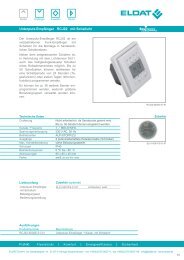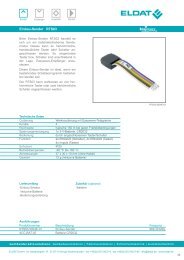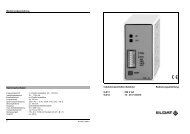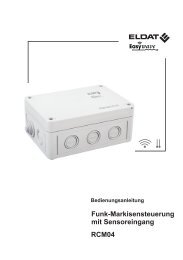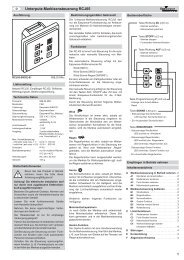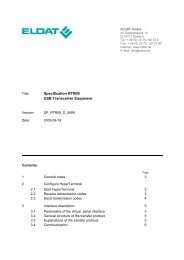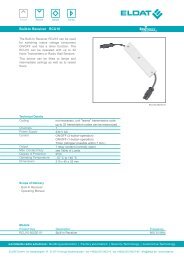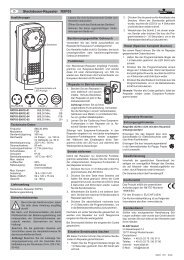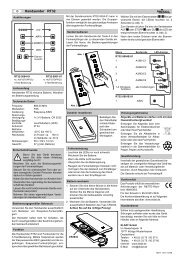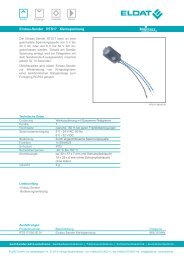Specification of RTRM08 Transceiver Module Easywave I2C - ELDAT
Specification of RTRM08 Transceiver Module Easywave I2C - ELDAT
Specification of RTRM08 Transceiver Module Easywave I2C - ELDAT
Create successful ePaper yourself
Turn your PDF publications into a flip-book with our unique Google optimized e-Paper software.
<strong>Specification</strong><br />
Index 1.01<br />
Project No.<br />
RF-Products, Controller <strong>RTRM08</strong> <strong>Transceiver</strong> <strong>Module</strong> Easw I 2 C Page 15<br />
Development<br />
Production S. Schreiber 2007-08-24<br />
Register<br />
Address<br />
Register Name Description <strong>of</strong> Register<br />
7007<br />
• 0x04 (LN_RQ)<br />
The module is in Learn Mode. When the module enters the Learn<br />
Mode, it switches on its transceiver and tries receiving <strong>Easywave</strong><br />
telegrams. The module learns the first <strong>Easywave</strong> telegram which it<br />
receives.<br />
The / REQ output indicates whether the module has received and<br />
learned an <strong>Easywave</strong> telegram.<br />
When the module terminates the Learn Mode (because another value<br />
than LN_RQ is written into the RX_MODE register), the module switches<br />
its transceiver on or <strong>of</strong>f according to the desired mode.<br />
(Please refer to “Learning <strong>of</strong> <strong>Easywave</strong> Telegrams“ on page 21.)<br />
• 0x05 (LN_PL)<br />
The module is in Learn Mode just as with the LN_RQ mode value, but<br />
the / REQ output always remains inactive. Polling <strong>of</strong> the RX_STATUS<br />
register is the only way <strong>of</strong> determining whether the module has<br />
received and learned an <strong>Easywave</strong> telegram.<br />
When the module terminates the Learn Mode (because another value<br />
than LN_PL is written into the RX_MODE register), the module switches<br />
its transceiver on or <strong>of</strong>f according to the desired mode.<br />
(Please refer to “Learning <strong>of</strong> <strong>Easywave</strong> Telegrams“ on page 21.)<br />
• 0x06 (DELLN)<br />
The module's transceiver is switched <strong>of</strong>f. The module deletes a learned<br />
<strong>Easywave</strong> telegram.<br />
The / REQ output is not asserted.<br />
(Please refer to “Delete Learned <strong>Easywave</strong> Telegrams“ on page 22.)<br />
0x01 RX_STATUS Rx Status register. This register indicates received and learned <strong>Easywave</strong><br />
telegrams while being in Rx mode or Learn mode.<br />
The RX_STATUS register is a read-only register, a write to the register has<br />
not any effect.<br />
• Bit 7: (RX_TEL_CHANGED)<br />
The RX_TEL_CHANGED bit is set to 1 if the received <strong>Easywave</strong><br />
telegram changes while being in Receive Mode: An <strong>Easywave</strong> telegram<br />
has received or an <strong>Easywave</strong> telegram has been received which differs<br />
from the preceding one or there is not any further valid <strong>Easywave</strong><br />
telegram received.<br />
If the RX_TEL_CHANGED bit is set from 0 to 1, the transceiver module<br />
sets the RX_CHANNEL and RX_BUTTON registers, and the<br />
RX_TEL_VALID bit in this Rx Status register according to the received<br />
<strong>Easywave</strong> telegram.<br />
While the RX_TEL_CHANGED bit is 1, the RX_CHANNEL and<br />
RX_BUTTON registers and the RX_TEL_VALID bit in this Rx Status<br />
register won't change their contents even if another <strong>Easywave</strong> telegram<br />
is received.<br />
Reading the RX_ACK register clears the RX_TEL_CHANGED bit.<br />
(Please refer to “Receiving <strong>of</strong> <strong>Easywave</strong> Telegrams“ on page 19.)




